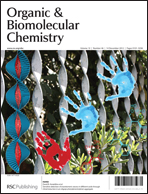Breaking the regioselectivity of indole prenyltransferases: identification of regular C3-prenylated hexahydropyrrolo[2,3-b]indoles as side products of the regular C2-prenyltransferase FtmPT1†
Abstract
The prenyltransferase FtmPT1 from Aspergillus fumigatus is involved in the biosynthesis of fumitremorgin-type alkaloids and catalysed the regular C2-prenylation of brevianamide F (cyclo-L-Trp-L-Pro). It has been shown that FtmPT1 also accepted a number of other tryptophan-containing cyclic dipeptides and prenylated them, in the presence of dimethylallyl diphosphate, at C-2 of the indole nucleus. Detailed analysis of the incubation mixtures of FtmPT1 with these cyclic dipeptides revealed the presence of additional product peaks in the HPLC chromatograms. Seven regularly C3-prenylated hexahydropyrrolo[2,3-b]indoles were isolated and identified by HR-ESI-MS and NMR analyses including HMBC, HMQC and NOESY experiments. Further experiments proved that the C2- and C3-prenylated products are both independent enzyme products. To the best of our knowledge, this is the first report on the enzymatic formation of regularly C3-prenylated indolines. A reaction mechanism for both C2- and C3-prenylated derivatives was proposed.
![Graphical abstract: Breaking the regioselectivity of indole prenyltransferases: identification of regular C3-prenylated hexahydropyrrolo[2,3-b]indoles as side products of the regular C2-prenyltransferase FtmPT1](/en/Image/Get?imageInfo.ImageType=GA&imageInfo.ImageIdentifier.ManuscriptID=C2OB26149A&imageInfo.ImageIdentifier.Year=2012)

 Please wait while we load your content...
Please wait while we load your content...